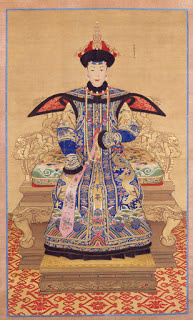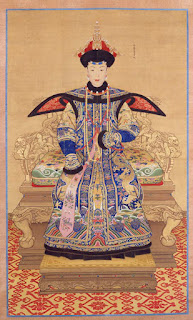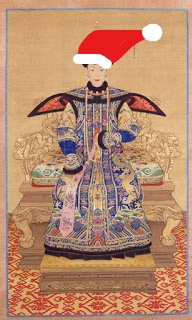Jade Emperor Pagoda - a Ho Chi Minh City gem
It was only a matter of time before this Jade(d) Empress was drawn back once again to the 'Jade Emperor Pagoda' (as planned in my “Top Ten Must-Do's For My Saigon Grand Entrance” which, of course, you've read, here ) after numerous visits spanning two decades.
Why… A past love in another life? A distant ancestral family member? A kindred spirit? Who knows? Or just maybe, because the Jade Emperor Pagoda (Chua Ngoc Hoang) ranks as one of Ho Chi Minh City’s (Saigon) five most important shrines and one of its most evocative and stunning pagodas. A surreal feast for the eyes and jam-packed with fantastical décor, this little gem is certainly one of the most impressive pagodas in town. Well, what did you expect with a Jade Emperor involved?
General consensus is that the Jade Emperor Pagoda was built in 1909 by the Chinese Cantonese community, immigrants who settled in Saigon of old – although it looks much older. The richly decorated interiors and architectural style is distinctive of southern Chinese Buddhist elements.
Amazing that this exquisite cultural relic still stands amongst the urban concrete jungle that has sprouted up around it in present-day Ho Chi Minh City (HCMC). And conveniently located in the upper fringes of central District One means you don’t have to haul yourself over to Chinatown, or ‘Cholon,’ where most of the city’s stash of ancient pagodas and temples are tucked away (but do try and get over there another time, as these too, are spectacular).
Similar to those in Cholon, HCMC and elsewhere in Vietnam, although from another century, the Jade Emperor Pagoda is still open house and fully operational as a place of worship. As Buddhism and Taoism are inextricably intertwined here, worshippers practice both Mahayana Buddhism and Taoism – Vietnam’s main religious and philosophical influences.
Actually, it should be noted that since 1984, the official name has been ‘Tortoise Pagoda’ (or Chua Phuoc Hai, its Chinese name), for reasons explained later. However, like me, most folk still refer to it as the Jade Emperor Pagoda as it’s dedicated to the supreme Taoist God, Jade Emperor (Ngoc Hoang), or ‘King of Heaven.’ Legend has it that it is the Jade Emperor himself who heads-up and manages all things heaven and earth and holds the ultimate right to decide who sets foot in heaven, or who will be cast off to hell. With the Jade Emperor ruling over the heavenly kingdom, only divine servants communicate with him, as his rank is way too exalted to be responsible for mere mortals (although in Chinese Taoism lore, he does enjoy relative popularity). Consequently, there are only a handful of statues and altars in his honour and allegedly, this is the only site in Vietnam where the Jade Emperor is publicly worshipped. Another reason why you must visit.
This surprisingly compact, rose-hued pagoda unassumingly rests down a quiet side-street, set in a 2,300-square-metre, courtyard-style compound shaded by gnarly old trees. Its entrance is typically flanked by two stone dragons and a front façade emblazoned with large red Chinese characters. The cavernous worshipping space is divided into multi-sized chambers with a central main hall, connected by narrow passageways. Dimly-lit, dark wood interiors are punctuated with glowing red lanterns and occasional shafts of light beaming through open wooden rafters.
And atop of the peeling rose paint, walls are adorned with worshipping paintings, intricate wood carving scenes and gilt-edged tablets and parallel sentences displaying golden Chinese characters.
Upon entering, it isn’t just a case of adjusting your eyes from the harsh tropical sunlight to the contrasting darkness, but also to the pungent fug of smoke that envelopes the pagoda’s interiors – swirling from incense coils hanging from the rafters, smoky joss sticks planted vertical in bronze urns and omnipresent burning oil lamps and candles. It all however adds to the atmosphere, which you could almost cut with a knife, literally.
The Jade Emperor Pagoda is a fluid scene of a constant round of worshippers coming and going, bowing and praying, making offerings, lighting incense and chiming bells at regular intervals, intermixed with pagoda caretakers diligently renewing the oil lamps, vases of wilted flowers and overripe fruit offerings and discarding the overflowing red stubs of burnt-down joss sticks and candles.
The cramped outer chamber to the main hall is guarded either side by a duo of imposing, 4-metre-tall statues, Taoist Generals that brandish both swords and dramatic mustaches. Facing the central altar and the giant bronze urn placed in front.... to your right, one quite mesmerising General (he looks vaguely familiar, did we meet in a previous lifetime?) who defeated the Green Dragon, representing Yang, who now rests underfoot.
Carry on through to the main hall, the place to worship the Jade Emperor, a large elaborately carved statue, ornately-robed and again, impressively mustachioed. For someone so powerful, he looks surprisingly affable.
Positioned at the epicentre of the pagoda, the Emperor is surrounded by his henchmen, the Four Big Diamonds (Tu Dai Kim Cuong), so-called apparently because of their gem-like toughness....
plus a bunch of genies, helping him govern and decide who can (or cannot) enter the higher heavenly realm.
Worshippers pray for their best outcome at the front altar, laden with incense coils, candles and fresh flowers and fruits.
If you aren’t able to squeeze past the Gate of Heaven, be prepared to meet the not-so-affable (read: fearsome) Thanh Hoang, the ‘Chief of Hell,’ or 'God of Hell,’ who lurks in the Hall of Ten Hells, a semi-enclosed chamber left of the main hall. This Chief of Hell is flanked by two magical red horses and an entourage of ‘Gods,’ aptly attired in sinister black garb; it is they who apparently send sinners and wicked transgressors – both male and female – to the Ten Levels of Hell and dispense these grotesque punishments for evil acts.
If you’re in any way unclear about what these Ten Levels of Hell are, don't worry, they are graphically illustrated in a series of intricately carved, dark-wood reliefs along the chamber walls; eye-watering torments and tortures administered for eternity. I don’t really relish having to explain what any of these punishments are, but you may be able to get the gist of them looking closely at my photographs; the more sensitive among you should scroll down through these images mighty fast.....
You could drag a naughty child in here and sternly warn them, “See, this is what happens to you if you misbehave!” but they could well end-up psychologically scarred for life from this – not to mention, the adults.
Seated near the menacing Chief of Hell, an effigy of the 'City God' wears a hat inscribed with Chinese characters declaring, 'At one glance, money is given'. Which spurs on worshipper's to believe a blessing ritual undertaken here will make them rich: depositing money into a box beside the City God, taking a postage stamp-sized red folded paper from a bowl and then rubbing it against the statue’s hand, then circling the statue with a lit candle (or something to that effect).
Both of the 'messenger' red horse statues (one for women, one for men), has a bell dangling from its neck, which should be rung loudly to assist prayers ascend to the Gods - expect a continual clanking of bells while in this chamber.
Straight out of hell, the adjoining side-room dedicated to Kim Hua (AKA Kim Hoa Thanh Mau), ‘Chief of All Women’ and ‘Goddess of Fertility,’ comes as a welcome relief.
Kim Hua’s modest-sized statue is surrounded by 12 ceramic figurines weighed-down with small children and seated in two rows of six. These 12 ladies are believed to be midwives and wet nurses representing the gamut of human traits from the wonderfully good to the worst excesses, as well as each of the 12 years in the Chinese astrological calendar.
Many childless women, couples, or even their anxious relatives, flock here to pray for a baby. If their offspring dreams come true, they are compelled to return and show their gratitude for their good fortune, making offerings to Kim Hua. Perhaps why this low-ceilinged, minuscule chamber invariably gets congested – a post-Hell bottle neck if you will!
To the right of the main hall, pass another chamber dedicated to a deity ......
and take the wooden stairs up to a balcony, which leads out to a sunny rooftop terrace. As well as offering a tranquil spot and breather from the melee (and smoke), you’ll get an up-close view of the pagoda’s exquisite roof of jade-coloured, yin-yang tiles and encrusted edges of intricate, hand-painted ceramic figurines and arched dragons, birds and animals.
The small room on the stairwell’s opposite side is dedicated to a neon-haloed statue of Quan Am, 'Goddess of Mercy' or 'Bodhisattva of Compassion' – a regular sight in Buddhist pagodas and shrines in Vietnam.
On exiting the pagoda, just outside on your left, the murky pond seething with tortoises explains the ‘Tortoise Pagoda’ moniker.
 |
| Of course, my visit coincides with the pond clean out! Tortoises today make do without water... |
An ancient Taoist symbol, tortoises are believed to provide divine protection and releasing them into the pond (or even feeding them) is supposed to generate karma merit or good luck. Apparently, tortoises are sold by vendors at the main gate, which, I’d imagine, doesn’t go down too well with animal lovers (nor, this Jade(d) Empress), but it's all part of ancient pagoda rituals.
Not surprisingly, with its impressive cultural and historical heritage, the pagoda attracts a vast number of locals, visitors and tour groups and the site can get a tad overrun at times. If you want more peace and to avoid the crowds (good luck), arrive super early and certainly don’t turn-up during major Buddhist festivals, such as pre-Tet (Lunar New Year) and the Jade Emperor’s birth anniversary in January, the first and fifteenth days of the month (new and full moon), Buddha’s birthday and Mid-Autumn festival (conversely, these make awesome opportunities if you want to experience genuine Buddhist-Taoist festivals).
Not that I’m biased or anything, but if you only have time to visit one pagoda in Ho Chi Minh City, then make it the Jade Emperor – or Tortoise – Pagoda.
73 Mai Thi Luu, District One
Open daily from 7am to 6pm. No entrance fee but a small donation in the boxes provided I'm sure would be most appreciated!
Disclaimer: this Jade(d) Empress has the best intentions to impart correct information from her research based on various sources. So her apologies if there is anything incorrect or offensive written here, perhaps write a note to let her know if this case. Thank you.


















































Comments
Post a Comment